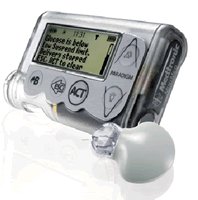Insulin Pumps Operating Instructions
I've gathered here a lot of information about insulin pumps.
You don't need to be an expert of it overnight.
If you are uncertain about anything, you can go to your diabetes care team for help.
Everyone learns at a different pace and it is ok if it takes you a while to get the hang of it.

So your doctor has recommended you the insulin pump to use.
You've chosen your brand and you've become comfortable with all of the options of it.
You have to do the following for getting started:
Setting Up
To use the pump, the reservoir must first be filled with insulin. Some pumps use prefilled cartridges that are replaced when empty. Most, however, are filled with the insulin prescribed for the user (usually Apidra Humalog or Novolog).

Setting up includes:
- Opening a new (sterile) empty pump reservoir.
- Withdrawing the plunger.
- Inserting the needle into a vial of insulin.
- Injecting the air from the reservoir into the vial to prevent a vacuum forming in the vial as insulin is withdrawn.
- Drawing insulin into the reservoir with the plunger, and then removing the needle.
- Squirting out any air bubbles from the reservoir, and then removing the plunger.
- Attaching the reservoir to the infusion set tubing.
- Installing the assembly into the pump and priming the tubing (pushing insulin and any air bubbles through the tubing).
Remember!You have to this with the pump while it's disconnected from the body to prevent accidental insulin delivery. - Attaching to the infusion site (and priming the cannula if a new set has been inserted).
Getting Started
- Determine how much insulin to use in the insulin pump by averaging the total units of insulin you use per day for several days.
(You may start with about 20% less if you are switching to rapid-acting insulin). - Divide the total dosage into 40-50% for basal and 50-60% for bolus insulin.
- Divide the basal portion by 24 to determine a beginning hourly basal rate.
- Then, adjust the hourly basal rate up or down for patterns of highs and lows, such as more insulin for dawn phenomenon and less for daily activity.
- Determine a beginning carbohydrate dose (insulin : carb ratio) using the 450 (or 500) rule.
Divide by the total units of insulin/day to get the number of grams of carbohydrate covered by one unit of insulin.
This dose may be raised or lowered based on your history and how much fast-acting insulin you took in the past. - Determine the dose of insulin to correct high blood glucose with the 1800 (or 1500) rule.
Divide 1800 by the total units of insulin/day to see how much one unit of insulin lowers your blood glucose.
This dose must be evaluated by your doctor.
Remember!
It might be often too high for children or for people who have recently diagnosed as diabetic.

|
Return from Insulin Pumps to Diabetes Supplies |